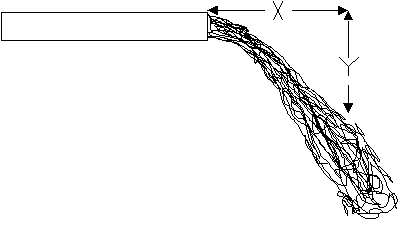Chemical and Process Engineering Resources
Measure Discharge Flow from a Horizontal Pipe
Nov 08 2010 01:30 PM | Chris HaslegoEver been confronted with the exit of a horizontal pipe full of flow? Wouldn't it be nice if there was a simple method to determine the flow rate in the pipe? Here's a method that may help.
This works surprisingly well and is very easy to do. All measurements are in inches. The formula is invalid for any other units. Also, the discharging pipe must be full of liquid.
 |
| Figure 1: Schematic Diagram |
Using a yardstick, measure any convenient distance X across the top of the liquid discharge (Figure 1).  Then measure the corresponding drop distance Y from the end of X to the top of the liquid. Measure the diameter of the pipe in inches.
 | Eq. (1) |
For example – measure a distance, X, of 24 inches across the top of the flowing discharge from the end of a 2 inch diameter pipe. Then measure vertically to the top of the liquid discharge, Y, say it is 25 inches. Then by the formula, the flow in the pipe in gallons per minute is:
2.56 times 24 times 2 squared divided by the square root of 25 =
2.56 times 96 divided by 5 =
49.15 say 50 GPM
References
- "Engineering Handbook of Conversion Factors" by Combustion Engineering, 1977, pg.142.

 FB
FB

4 Comments
x= velocity (in/s) * t
y= 1/2 * 386.088 in/s^2 * t^2 (gravitational acceleration)
x/sqrt(y) = velocity (in/s) /13.894 (time cancels out)
velocity = flow (gpm) * 231 in^3/gal * 1 min/60 sec/(.25*d^2*pi) (change units and divide by area)
velocity = flow /d^2 *4.9 (simplify)
x/sqrt(y) = 0.353 * flow/d^2 (replace velocity from prior equation and simplify)
flow (GPM) = X * d^2 * 2.83 / sqrt(Y) (solve for flow)
Whats the basis of taking Y...suppose the distance from ground to pipe that the liquid is falling is very high..